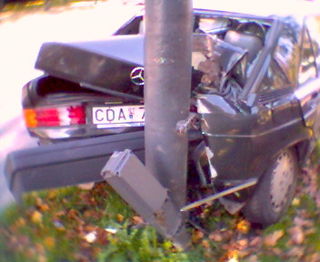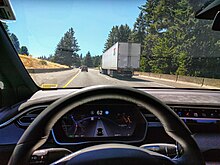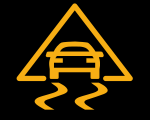
A self-driving car, also known as an autonomous car (AC), driverless car, robotaxi, robotic car or robo-car, is a car that is capable of operating with reduced or no human input. Self-driving cars are responsible for all driving activities, such as perceiving the environment, monitoring important systems, and controlling the vehicle, which includes navigating from origin to destination.

Automotive safety is the study and practice of automotive design, construction, equipment and regulation to minimize the occurrence and consequences of traffic collisions involving motor vehicles. Road traffic safety more broadly includes roadway design.

In road-transport terminology, a lane departure warning system (LDWS) is a mechanism designed to warn the driver when the vehicle begins to move out of its lane on freeways and arterial roads. These systems are designed to minimize accidents by addressing the main causes of collisions: driver error, distractions and drowsiness. In 2009 the U.S. National Highway Traffic Safety Administration (NHTSA) began studying whether to mandate lane departure warning systems and frontal collision warning systems on automobiles.

Vehicular automation involves the use of mechatronics, artificial intelligence, and multi-agent systems to assist the operator of a vehicle such as a car, lorries, aircraft, or watercraft. A vehicle using automation for tasks such as navigation to ease but not replace human control, qualify as semi-autonomous, whereas a fully self-operated vehicle is termed autonomous.
The term active safety is used in two distinct ways.

Adaptive cruise control (ACC) is a type of advanced driver-assistance system for road vehicles that automatically adjusts the vehicle speed to maintain a safe distance from vehicles ahead. As of 2019, it is also called by 20 unique names that describe that basic functionality. This is also known as Dynamic cruise control.

Vehicle safety technology (VST) in the automotive industry refers to the special technology developed to ensure the safety and security of automobiles and their passengers. The term encompasses a broad umbrella of projects and devices within the automotive world. Notable examples of VST include geo-fencing capabilities, remote speed sensing, theft deterrence, damage mitigation, vehicle-to-vehicle communication, and car-to-computer communication devices which use GPS tracking.
Intelligent speed assistance (ISA), or intelligent speed adaptation, also known as alerting, and intelligent authority, is any system that ensures that vehicle speed does not exceed a safe or legally enforced speed. In case of potential speeding, the driver can be alerted or the speed reduced automatically.

The driver monitoring system, also known as driver attention monitor, is a vehicle safety system to assess the driver's alertness and warn the driver if needed and eventually apply the brakes. It was first introduced by Toyota in 2006 for its and Lexus' latest models. It was first offered in Japan on the GS 450h. The system's functions co-operate with the pre-collision system (PCS). The system uses infrared sensors to monitor driver attentiveness. Specifically, the driver monitoring system includes a CCD camera placed on the steering column which tracks the face, via infrared LED detectors. If the driver is not paying attention to the road ahead and a dangerous situation is detected, the system will warn the driver by flashing lights, warning sounds. If no action is taken, the vehicle will apply the brakes. This system is said to be the first of its kind.

A collision avoidance system (CAS), also known as a pre-crash system, forward collision warning system (FCW), or collision mitigation system, is an advanced driver-assistance system designed to prevent or reduce the severity of a collision. In its basic form, a forward collision warning system monitors a vehicle's speed, the speed of the vehicle in front of it, and the distance between the vehicles, so that it can provide a warning to the driver if the vehicles get too close, potentially helping to avoid a crash. Various technologies and sensors that are used include radar (all-weather) and sometimes laser (LIDAR) and cameras to detect an imminent crash. GPS sensors can detect fixed dangers such as approaching stop signs through a location database. Pedestrian detection can also be a feature of these types of systems.

Back-up collisions happen when a driver reverses the car into an object, person, or other car. Although most cars come equipped with rear view mirrors which are adequate for detecting vehicles behind a car, they are inadequate on many vehicles for detecting small children or objects close to the ground, which fall in the car's blind spot, particularly directly aft. That area has been called a "killing zone." Large trucks have much larger blind spots that can hide entire vehicles and large adults.
A connected car is a car that can communicate bidirectionally with other systems outside of the car. This connectivity can be used to provide services to passengers or to support or enhance self-driving functionality. For safety-critical applications, it is anticipated that cars will also be connected using dedicated short-range communications (DSRC) or cellular radios, operating in the FCC-granted 5.9 GHz band with very low latency.

The World Forum for Harmonization of Vehicle Regulations define AEBS. UN ECE regulation 131 requires a system which can automatically detect a potential forward collision and activate the vehicle braking system to decelerate a vehicle with the purpose of avoiding or mitigating a collision. UN ECE regulation 152 says deceleration has to be at least 5 metres per second squared.

Mobileye Global Inc. is an Israeli autonomous driving company. It is developing self-driving technologies and advanced driver-assistance systems (ADAS) including cameras, computer chips, and software. Mobileye was acquired by Intel in 2017 and went public again in 2022.
Emergency Assist is a driver assistance system that monitors driver behavior by observing delays between the use of the accelerator and the brake; once a preset threshold of time has been exceeded the system will take control of the vehicle in order to bring it to a safe stop.

Tesla Autopilot is an advanced driver-assistance system (ADAS) developed by Tesla that amounts to partial vehicle automation. Tesla provides "Base Autopilot" on all vehicles, which includes lane centering and traffic-aware cruise control. Owners may purchase an upgrade to "Enhanced Autopilot" (EA) which adds semi-autonomous navigation on limited access roadways, self-parking, and the ability to summon the car from a garage or parking spot. The company claims the features reduce accidents caused by driver negligence and fatigue from long-term driving. Collisions and deaths involving Tesla cars with Autopilot engaged have drawn the attention of the press and government agencies.

In road-transport terminology, lane centering, also known as auto steer or autosteer, is an advanced driver-assistance system that keeps a road vehicle centered in the lane, relieving the driver of the task of steering. Lane centering is similar to lane departure warning and lane keeping assist, but rather than warn the driver, or bouncing the car away from the lane edge, it keeps the car centered in the lane. Together with adaptive cruise control (ACC), this feature may allow unassisted driving for some length of time. It is also part of automated lane keeping systems.
The death of Elaine Herzberg was the first recorded case of a pedestrian fatality involving a self-driving car, after a collision that occurred late in the evening of March 18, 2018. Herzberg was pushing a bicycle across a four-lane road in Tempe, Arizona, United States, when she was struck by an Uber test vehicle, which was operating in self-drive mode with a human safety backup driver sitting in the driving seat. Herzberg was taken to the local hospital where she died of her injuries.

A self-driving truck, also known as an autonomous truck or robo-truck, is an application of self-driving technology aiming to create trucks that can operate without human input. Alongside light, medium, and heavy-duty trucks, many companies are developing self-driving technology in semi trucks to automate highway driving in the delivery process.
Automated lane keeping systems (ALKS), also described as traffic jam chauffeurs, is an autonomous driving system that doesn't require driver supervision on motorways. ALKS is an international standard set out in UN-ECE regulation 157 and amounts to Level 3 vehicle automation. It is essentially a more robust combination of adaptive cruise control (ACC) and lane centering assist (LCA). When activated, it allows the driver to do non-driving tasks until alerted otherwise.





















